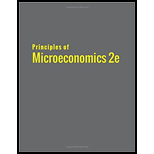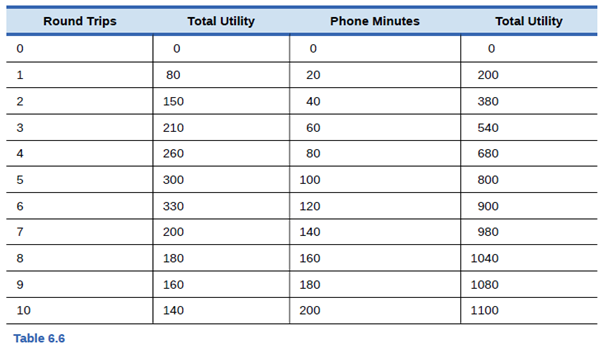
Jeremy is deeply in love with Jasmine. Jasmine lives where cell phone coverage is poor, so he can either call her on the land-line phone for five cents per minute or he can drive to see her, at a round—trip cost of

Using the values in given table, find out the points on Jeremy’s consumption choice budget constraint and identify his utility maximizing point?
Answer to Problem 1SCQ
The maximum total utility is 1120 on round 1 with 80 utility and 160 minutes of phone minutes within the given $10.
Explanation of Solution
It is given that Jeremy has total $10 to spend ,a round trips costs him $2 and phone calls costs $0.05 per minute. With the given money, he can either go for 5 round trips or no phone calls. second option is no round trips and 200 minutes of phone calls. there can be the combination of two in between. hence the budget constraint formulae is
Total amount=Price of round trips*Quantity of round trips+ Price of phone calls*Quantity of phone calls
A =P(r)*Q(r)+P(pc)*Q(pc)
$10=$2*Q(r)+$0.05*Q(pc)
dividing the whole equation by $0.05
$10/0.05=($2*Q(r)+$0.05*Q(pc))/0.05
200= 40*Q(r)+Q(pc)
Q(pc)=200-40*Q(r)
Hence with the given budget constraint and table, below table is constructed which shows zero to five round trips and how many phone minutes can be afforded with the given budget with total utility of each.
Concept introduction:
Budget Constraint: It represent all the possible combination of goods and services that a consumer can purchase with the given prices and income.
Want to see more full solutions like this?
Chapter 6 Solutions
PRINCIPLES OF MICROECONOMICS (OER)
Additional Business Textbook Solutions
Financial Accounting (12th Edition) (What's New in Accounting)
Horngren's Cost Accounting: A Managerial Emphasis (16th Edition)
Corporate Finance (4th Edition) (Pearson Series in Finance) - Standalone book
Managerial Accounting (5th Edition)
MARKETING:REAL PEOPLE,REAL CHOICES
Financial Accounting, Student Value Edition (5th Edition)
- Answerarrow_forwardM” method Given the following model, solve by the method of “M”. (see image)arrow_forwardAs indicated in the attached image, U.S. earnings for high- and low-skill workers as measured by educational attainment began diverging in the 1980s. The remaining questions in this problem set use the model for the labor market developed in class to walk through potential explanations for this trend. 1. Assume that there are just two types of workers, low- and high-skill. As a result, there are two labor markets: supply and demand for low-skill workers and supply and demand for high-skill workers. Using two carefully drawn labor-market figures, show that an increase in the demand for high skill workers can explain an increase in the relative wage of high-skill workers. 2. Using the same assumptions as in the previous question, use two carefully drawn labor-market figures to show that an increase in the supply of low-skill workers can explain an increase in the relative wage of high-skill workers.arrow_forward
- Published in 1980, the book Free to Choose discusses how economists Milton Friedman and Rose Friedman proposed a one-sided view of the benefits of a voucher system. However, there are other economists who disagree about the potential effects of a voucher system.arrow_forwardThe following diagram illustrates the demand and marginal revenue curves facing a monopoly in an industry with no economies or diseconomies of scale. In the short and long run, MC = ATC. a. Calculate the values of profit, consumer surplus, and deadweight loss, and illustrate these on the graph. b. Repeat the calculations in part a, but now assume the monopoly is able to practice perfect price discrimination.arrow_forwardThe projects under the 'Build, Build, Build' program: how these projects improve connectivity and ease of doing business in the Philippines?arrow_forward
 Microeconomics: Principles & PolicyEconomicsISBN:9781337794992Author:William J. Baumol, Alan S. Blinder, John L. SolowPublisher:Cengage Learning
Microeconomics: Principles & PolicyEconomicsISBN:9781337794992Author:William J. Baumol, Alan S. Blinder, John L. SolowPublisher:Cengage Learning Exploring EconomicsEconomicsISBN:9781544336329Author:Robert L. SextonPublisher:SAGE Publications, Inc
Exploring EconomicsEconomicsISBN:9781544336329Author:Robert L. SextonPublisher:SAGE Publications, Inc
 Principles of Economics 2eEconomicsISBN:9781947172364Author:Steven A. Greenlaw; David ShapiroPublisher:OpenStax
Principles of Economics 2eEconomicsISBN:9781947172364Author:Steven A. Greenlaw; David ShapiroPublisher:OpenStax Economics (MindTap Course List)EconomicsISBN:9781337617383Author:Roger A. ArnoldPublisher:Cengage Learning
Economics (MindTap Course List)EconomicsISBN:9781337617383Author:Roger A. ArnoldPublisher:Cengage Learning





